With Valentine’s Day just passing, a comment came back to me out of my lifetime of conversations. Thirty years ago, I was visiting a nursing home resident’s wife as we prepared for his funeral. The old lady summed up their 60-plus-year marriage with the words, “I don’t think I ever loved him.”
How sad is that?
As a nursing home chaplain, I did not get to know patients and their spouses in their best days. They came to us a shell of their former selves.
He seemed to be a quiet introvert. He spent most of each day in his wheelchair, listening to recorded history books. She was friendly and faithful with her daily visits. She seemed happy.
A steady job and homemaking skills
They lived in Chicago, during The Depression. They attended the same church, a good place to meet like-minded people. He was 28 and she was 18 on their wedding day. He had a good job as a schoolteacher. She lived at home with her parents.
This was a different time when women mostly thought about finding a man to provide for them. Men were looking for a woman to bear their children and make the home. Evidently, at least for this couple, love was farther down the list of desired qualities in a long-lasting marriage. And yet they stayed together for 60 years.
Leaving a loveless marriage
 Nowadays people handle loveless marriages differently. My friend’s husband left her for another woman after 30 years of marriage. A couple of months after he moved out, he told my friend, “I feel for her what I always wanted to feel for you.” She thinks he never loved her.
Nowadays people handle loveless marriages differently. My friend’s husband left her for another woman after 30 years of marriage. A couple of months after he moved out, he told my friend, “I feel for her what I always wanted to feel for you.” She thinks he never loved her.
After a several years of being single, my friend married again. This time it was to a man who truly loved her. She had made a list of qualities she wanted to look for in a husband. She told me, “I made this list, and, for some reason, I did not have on the list ‘someone who loves me.’ Turns out, that was the most important quality. You would think I would have thought about love first.”
Perhaps a third way — falling in love with your spouse
 Which is the better way? Staying in a loveless marriage or leaving it to find your true love? Or is there a third way? Falling in love with your spouse. It would have taken work and probably therapy. There must have been some small spark of love at the start. Perhaps that was an ember that could have been rekindled.
Which is the better way? Staying in a loveless marriage or leaving it to find your true love? Or is there a third way? Falling in love with your spouse. It would have taken work and probably therapy. There must have been some small spark of love at the start. Perhaps that was an ember that could have been rekindled.
The old lady was of a different generation, so she had little awareness that she could have asked for more out of her marriage. My friend’s ex was of the mindset to take care of himself first, even if that meant finding love outside of the marriage.
Perhaps they both missed what could have been.
Happy Valentine’s Day!
__________________________________________
Chaplain Hank Dunn is the author of Hard Choices for Loving People: CPR, Feeding Tubes, Palliative Care, Comfort Measures and the Patient with a Serious Illness and Light in the Shadows. Together they have sold over 4 million copies. You can purchase his books at hankdunn.com or on Amazon.

 “I know he would never want to be kept alive like this,” she said to me over the sound of a machine forcing air into her husband’s lungs. He lay motionless, eyes closed. He had been like this for months after arriving at the nursing home from the hospital.
“I know he would never want to be kept alive like this,” she said to me over the sound of a machine forcing air into her husband’s lungs. He lay motionless, eyes closed. He had been like this for months after arriving at the nursing home from the hospital. Since she was Jewish and asked this question, I gave her a copy of Rabbi Harold Kushner’s
Since she was Jewish and asked this question, I gave her a copy of Rabbi Harold Kushner’s 

 I listened to all 48 hours of this 900+ page book. It was worth every minute. Grant overcame so many setbacks to succeed as a general and President. Most significantly, according to Chernow, was his conquering his struggles with alcohol, a fact he does not mention in his own memoir. Had the Civil War never happened, history might not have known the name of U.S. Grant. It was his strategy to cut off the Southern states from beyond the Mississippi River with the fall of Vicksburg (July 1863), send Sherman through Georgia (1864), and capture Lee’s Army of Northern Virginia at Appomattox. There was no finer moment in his life than when he offered generous terms of surrender to Lee. He hoped to begin the healing of a fractured nation. Sadly, as President, he had to fight the South again as it rose in the K.K.K. We are fortunate, as a nation, that Grant and Lincoln rose to the top when we needed them.
I listened to all 48 hours of this 900+ page book. It was worth every minute. Grant overcame so many setbacks to succeed as a general and President. Most significantly, according to Chernow, was his conquering his struggles with alcohol, a fact he does not mention in his own memoir. Had the Civil War never happened, history might not have known the name of U.S. Grant. It was his strategy to cut off the Southern states from beyond the Mississippi River with the fall of Vicksburg (July 1863), send Sherman through Georgia (1864), and capture Lee’s Army of Northern Virginia at Appomattox. There was no finer moment in his life than when he offered generous terms of surrender to Lee. He hoped to begin the healing of a fractured nation. Sadly, as President, he had to fight the South again as it rose in the K.K.K. We are fortunate, as a nation, that Grant and Lincoln rose to the top when we needed them. Author Ty Seidule was born on July 3rd into a family culture steeped in the myth of righteous cause for which we Southerners fought. When people said, “too bad you weren’t born on the 4th,” he’d reply that he was glad to have been born on the day of Pickett’s charge (there it is again). Seidule rose through the ranks in the U.S. Army and taught at West Point. Through his academic research and soul-searching, he concluded that the “lost cause” myth of the South was wrong. According to Seidule, the Civil War was about slavery and the Confederate soldiers who took up arms against the U.S. government were traitors. He makes a compelling argument that we no longer need to honor these traitors with monuments or U.S. Army bases.
Author Ty Seidule was born on July 3rd into a family culture steeped in the myth of righteous cause for which we Southerners fought. When people said, “too bad you weren’t born on the 4th,” he’d reply that he was glad to have been born on the day of Pickett’s charge (there it is again). Seidule rose through the ranks in the U.S. Army and taught at West Point. Through his academic research and soul-searching, he concluded that the “lost cause” myth of the South was wrong. According to Seidule, the Civil War was about slavery and the Confederate soldiers who took up arms against the U.S. government were traitors. He makes a compelling argument that we no longer need to honor these traitors with monuments or U.S. Army bases.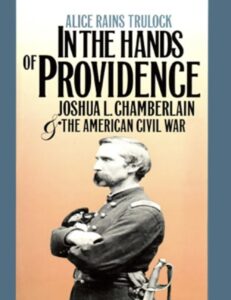 Like most, I knew of Chamberlain for only a few hours of his life on July 2, 1863, at Gettysburg. He commanded the 20th Maine at the extreme end of the Union line on Little Round Top. His troops were under repeated assault and running out of ammunition. Had he failed in defending his position, the entire U.S. Army on the field could have been destroyed in a flanking maneuver by the advancing Confederates. He ordered his men to fix bayonets, and they charged downhill, capturing more than 100 Southerners and saving the day. Many books and movies have captured this one moment. He was a college professor before the war. He became a college president and served four years as governor after returning to Maine. One other moving scene in Chamberlain’s military career was the last day of the war. He was the commander in charge of the ceremony at Appomattox, where the defeated rebels would surrender their arms. In the spirit that Grant set in the terms of surrender, Chamberlain ordered his men to salute their defeated foes, now countrymen once again.
Like most, I knew of Chamberlain for only a few hours of his life on July 2, 1863, at Gettysburg. He commanded the 20th Maine at the extreme end of the Union line on Little Round Top. His troops were under repeated assault and running out of ammunition. Had he failed in defending his position, the entire U.S. Army on the field could have been destroyed in a flanking maneuver by the advancing Confederates. He ordered his men to fix bayonets, and they charged downhill, capturing more than 100 Southerners and saving the day. Many books and movies have captured this one moment. He was a college professor before the war. He became a college president and served four years as governor after returning to Maine. One other moving scene in Chamberlain’s military career was the last day of the war. He was the commander in charge of the ceremony at Appomattox, where the defeated rebels would surrender their arms. In the spirit that Grant set in the terms of surrender, Chamberlain ordered his men to salute their defeated foes, now countrymen once again. With all believing God is on their side in a war, it is especially hard for the losers to explain what happened. This presented an exceptional problem for the dominant version of Christianity in the South (evangelical Protestant). In their view, the Yankees were more secular, more liberal, more urban, and less devoted Christians. This book by Charles Wilson, a former professor at the University of Mississippi and fellow church member with me in Oxford, explains the mental and theological gymnastics my Southern ancestors went through to explain how God was on their side. God sided with the South because their cause was righteous, but the North’s industrial strength was too much even for God. Dr. Wilson recently gave three lectures on this topic at St. Peter’s Episcopal Church in
With all believing God is on their side in a war, it is especially hard for the losers to explain what happened. This presented an exceptional problem for the dominant version of Christianity in the South (evangelical Protestant). In their view, the Yankees were more secular, more liberal, more urban, and less devoted Christians. This book by Charles Wilson, a former professor at the University of Mississippi and fellow church member with me in Oxford, explains the mental and theological gymnastics my Southern ancestors went through to explain how God was on their side. God sided with the South because their cause was righteous, but the North’s industrial strength was too much even for God. Dr. Wilson recently gave three lectures on this topic at St. Peter’s Episcopal Church in 


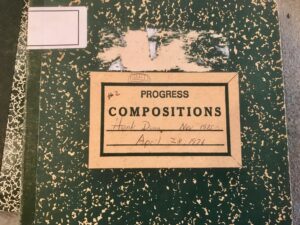
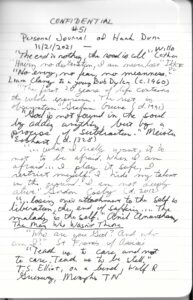
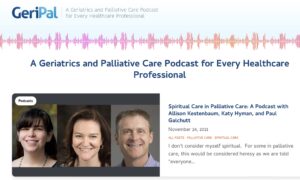 A
A  I was here to ponder how one place can hold so much grief and healing.
I was here to ponder how one place can hold so much grief and healing.
 It turns out her idea was masterful. The Wall has become a place of reflection and healing, a public place to grieve privately. Annually, millions walk the path by the wall in silence, as if in a sacred space — indeed it is. Grown men weep as they touch the name of a fallen comrade. Children visit the names of fathers they never knew.
It turns out her idea was masterful. The Wall has become a place of reflection and healing, a public place to grieve privately. Annually, millions walk the path by the wall in silence, as if in a sacred space — indeed it is. Grown men weep as they touch the name of a fallen comrade. Children visit the names of fathers they never knew. The story is about loss and backpacking, two abiding interests in my life. I’d probably write favorably of anyone who takes their grief on a 1,100-mile backpacking trip. Cheryl Strayed did and wrote about it.
The story is about loss and backpacking, two abiding interests in my life. I’d probably write favorably of anyone who takes their grief on a 1,100-mile backpacking trip. Cheryl Strayed did and wrote about it.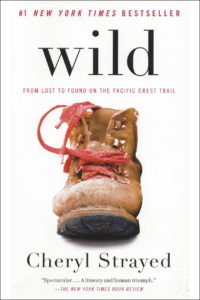 There are many moving passages in the book, but I was caught by one line on the next-to-last page of the book. Cheryl touches the bridge on the Columbia River, the site at the end of her journey. She walks back to an ice cream stand to buy herself a treat with the last two dollars she has to her name. She enjoys her ice cream, chatting with a lawyer from Portland who stops for ice cream, too. She says goodbye to him and
There are many moving passages in the book, but I was caught by one line on the next-to-last page of the book. Cheryl touches the bridge on the Columbia River, the site at the end of her journey. She walks back to an ice cream stand to buy herself a treat with the last two dollars she has to her name. She enjoys her ice cream, chatting with a lawyer from Portland who stops for ice cream, too. She says goodbye to him and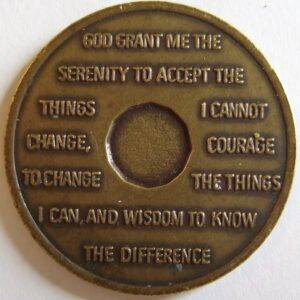
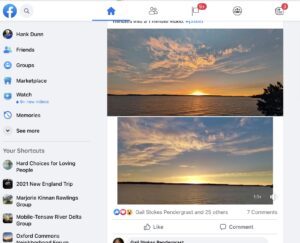 In my personal photo collection, I have scads of dawns and dusks. Sunrise in the swamp. Sunset from a mountaintop.
In my personal photo collection, I have scads of dawns and dusks. Sunrise in the swamp. Sunset from a mountaintop.



